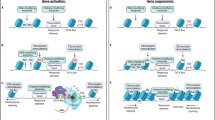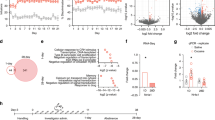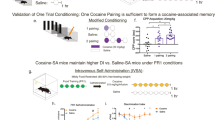Abstract
Reward-related memory is an important factor in cocaine seeking. One necessary signaling mechanism for long-term memory formation is the activation of poly(ADP-ribose) polymerase-1 (PARP-1), via poly(ADP-ribosyl)ation. We demonstrate herein that auto-poly(ADP-ribosyl)ation of activated PARP-1 was significantly pronounced during retrieval of cocaine-associated contextual memory, in the central amygdala (CeA) of rats expressing cocaine-conditioned place preference (CPP). Intra-CeA pharmacological and short hairpin RNA depletion of PARP-1 activity during cocaine-associated memory retrieval abolished CPP. In contrast, PARP-1 inhibition after memory retrieval did not affect CPP reconsolidation process and subsequent retrievals. Chromatin immunoprecipitation sequencing revealed that PARP-1 binding in the CeA is highly enriched in genes involved in neuronal signaling. We identified among PARP targets in CeA a single gene, yet uncharacterized and encoding a putative transposase inhibitor, at which PARP-1 enrichment markedly increases during cocaine-associated memory retrieval and positively correlates with CPP. Our findings have important implications for understanding drug-related behaviors, and suggest possible future therapeutic targets for drug abuse.
This is a preview of subscription content, access via your institution
Access options
Subscribe to this journal
Receive 12 print issues and online access
$259.00 per year
only $21.58 per issue
Buy this article
- Purchase on Springer Link
- Instant access to full article PDF
Prices may be subject to local taxes which are calculated during checkout





Similar content being viewed by others
Accession codes
References
Rogge GA, Wood MA . The role of histone acetylation in cocaine-induced neural plasticity and behavior. Neuropsychopharmacology 2013; 38: 94–110.
Everitt BJ, Dickinson A, Robbins TW . The neuropsychological basis of addictive behaviour. Brain Res Brain Res Rev 2001; 36: 129–138.
Kauer JA, Malenka RC . Synaptic plasticity and addiction. Nat Rev Neurosci 2007; 8: 844–858.
Bali P, Im HI, Kenny PJ . Methylation, memory and addiction. Epigenetics 2011; 6: 671–674.
Cahill L, McGaugh JL . Mechanisms of emotional arousal and lasting declarative memory. Trends Neurosci 1998; 21: 294–299.
Fu Y, Pollandt S, Liu J, Krishnan B, Genzer K, Orozco-Cabal L et al. Long-term potentiation (LTP) in the central amygdala (CeA) is enhanced after prolonged withdrawal from chronic cocaine and requires CRF1 receptors. J Neurophysiol 2007; 97: 937–941.
Nestler EJ . Molecular basis of long-term plasticity underlying addiction. Nat Rev Neurosci 2001; 2: 119–128.
Makris N, Gasic GP, Seidman LJ, Goldstein JM, Gastfriend DR, Elman I et al. Decreased absolute amygdala volume in cocaine addicts. Neuron 2004; 44: 729–740.
Paton JJ, Belova MA, Morrison SE, Salzman CD . The primate amygdala represents the positive and negative value of visual stimuli during learning. Nature 2006; 439: 865–870.
Fuchs RA, Weber SM, Rice HJ, Neisewander JL . Effects of excitotoxic lesions of the basolateral amygdala on cocaine-seeking behavior and cocaine conditioned place preference in rats. Brain Res 2002; 929: 15–25.
Oei SL, Griesenbeck J, Schweiger M, Babich V, Kropotov A, Tomilin N . Interaction of the transcription factor YY1 with human poly(ADP-ribosyl) transferase. Biochem Biophys Res Commun 1997; 240: 108–111.
Kim MY, Mauro S, Gevry N, Lis JT, Kraus WL . NAD+-dependent modulation of chromatin structure and transcription by nucleosome binding properties of PARP-1. Cell 2004; 119: 803–814.
Kraus WL, Lis JT . PARP goes transcription. Cell 2003; 113: 677–683.
Krishnakumar R, Kraus WL . The PARP side of the nucleus: molecular actions, physiological outcomes, and clinical targets. Mol Cell 2010; 39: 8–24.
Ju BG, Solum D, Song EJ, Lee KJ, Rose DW, Glass CK et al. Activating the PARP-1 sensor component of the groucho/ TLE1 corepressor complex mediates a CaMKinase IIdelta-dependent neurogenic gene activation pathway. Cell 2004; 119: 815–829.
Day JJ, Sweatt JD . Epigenetic mechanisms in cognition. Neuron 2011; 70: 813–829.
Goldberg S, Visochek L, Giladi E, Gozes I, Cohen-Armon M . PolyADP-ribosylation is required for long-term memory formation in mammals. J Neurochem 2009; 111: 72–79.
Hernandez AI, Wolk J, Hu JY, Liu J, Kurosu T, Schwartz JH et al. Poly-(ADP-ribose) polymerase-1 is necessary for long-term facilitation in Aplysia. J Neurosci 2009; 29: 9553–9562.
Cohen-Armon M, Visochek L, Katzoff A, Levitan D, Susswein AJ, Klein R et al. Long-term memory requires polyADP-ribosylation. Science 2004; 304: 1820–1822.
Fontan-Lozano A, Suarez-Pereira I, Horrillo A, del-Pozo-Martin Y, Hmadcha A . Carrion AM. Histone H1 poly[ADP]-ribosylation regulates the chromatin alterations required for learning consolidation. J Neurosci 2010; 30: 13305–13313.
O'Brien CP, Childress AR, Ehrman R, Robbins SJ . Conditioning factors in drug abuse: can they explain compulsion? J Psychopharmacol 1998; 12: 15–22.
Bonson KR, Grant SJ, Contoreggi CS, Links JM, Metcalfe J, Weyl HL et al. Neural systems and cue-induced cocaine craving. Neuropsychopharmacology 2002; 26: 376–386.
Miller CA, Marshall JF . Molecular substrates for retrieval and reconsolidation of cocaine-associated contextual memory. Neuron 2005; 47: 873–884.
Dudai Y . Reconsolidation: the advantage of being refocused. Curr Opin Neurobiol 2006; 16: 174–178.
Kelley LA, Mezulis S, Yates CM, Wass MN, Sternberg MJ . The Phyre2 web portal for protein modeling, prediction and analysis. Nat Protoc 2015; 10: 845–858.
Mahnke Braam LA, Goryshin IY, Reznikoff WS . A mechanism for Tn5 inhibition. carboxyl-terminal dimerization. J Biol Chem 1999; 274: 86–92.
Reznikoff WS . Transposon Tn5. Annu Rev Genet 2008; 42: 269–286.
Scobie KN, Damez-Werno D, Sun H, Shao N, Gancarz A, Panganiban CH et al. Essential role of poly(ADP-ribosyl)ation in cocaine action. Proc Natl Acad Sci USA 2014; 111: 2005–2010.
Tristan C, Shahani N, Sedlak TW, Sawa A . The diverse functions of GAPDH: views from different subcellular compartments. Cell Signal 2011; 23: 317–323.
Nakajima H, Kubo T, Ihara H, Hikida T, Danjo T, Nakatsuji M et al. Nuclear-translocated glyceraldehyde-3-phosphate dehydrogenase promotes poly(ADP-ribose) polymerase-1 activation during oxidative/nitrosative stress in stroke. J Biol Chem 2015; 290: 14493–14503.
Xu R, Serritella AV, Sen T, Farook JM, Sedlak TW, Baraban J et al. Behavioral effects of cocaine mediated by nitric oxide-GAPDH transcriptional signaling. Neuron 2013; 78: 623–630.
Martinez-Zamudio R, Ha HC . Histone ADP-ribosylation facilitates gene transcription by directly remodeling nucleosomes. Mol Cell Biol 2012; 32: 2490–2502.
Krishnakumar R, Gamble MJ, Frizzell KM, Berrocal JG, Kininis M, Kraus WL . Reciprocal binding of PARP-1 and histone H1 at promoters specifies transcriptional outcomes. Science 2008; 319: 819–821.
Maze I, Feng J, Wilkinson MB, Sun H, Shen L, Nestler EJ . Cocaine dynamically regulates heterochromatin and repetitive element unsilencing in nucleus accumbens. Proc Nat Acad Sci USA 2011; 108: 3035–3040.
Johansen JP, Cain CK, Ostroff LE, LeDoux JE . Molecular mechanisms of fear learning and memory. Cell 2011; 147: 509–524.
Everitt BJ, Cardinal RN, Parkinson JA, Robbins TW . Appetitive behavior: impact of amygdala-dependent mechanisms of emotional learning. Ann NY Acad Sci 2003; 985: 233–250.
Jentsch JD, Taylor JR . Impulsivity resulting from frontostriatal dysfunction in drug abuse: implications for the control of behavior by reward-related stimuli. Psychopharmacology (Berl) 1999; 146: 373–390.
Everitt BJ, Parkinson JA, Olmstead MC, Arroyo M, Robledo P, Robbins TW . Associative processes in addiction and reward. The role of amygdala-ventral striatal subsystems. Ann NY Acad Sci 1999; 877: 412–438.
See RE, McLaughlin J, Fuchs RA . Muscarinic receptor antagonism in the basolateral amygdala blocks acquisition of cocaine-stimulus association in a model of relapse to cocaine-seeking behavior in rats. Neuroscience 2003; 117: 477–483.
Kruzich PJ, See RE . Differential contributions of the basolateral and central amygdala in the acquisition and expression of conditioned relapse to cocaine-seeking behavior. J Neurosci 2001; 21: RC155.
Milekic MH, Brown SD, Castellini C, Alberini CM . Persistent disruption of an established morphine conditioned place preference. J Neurosci 2006; 26: 3010–3020.
Yu YJ, Chang CH, Gean PW . AMPA receptor endocytosis in the amygdala is involved in the disrupted reconsolidation of Methamphetamine-associated contextual memory. Neurobiol Learn Mem 2013; 103: 72–81.
Arguello AA, Hodges MA, Wells AM, Lara H 3rd, Xie X, Fuchs RA . Involvement of amygdalar protein kinase A, but not calcium/calmodulin-dependent protein kinase II, in the reconsolidation of cocaine-related contextual memories in rats. Psychopharmacology (Berl) 2014; 231: 55–65.
Lee BR, Ma YY, Huang YH, Wang X, Otaka M, Ishikawa M et al. Maturation of silent synapses in amygdala–accumbens projection contributes to incubation of cocaine craving. Nat Neurosci 2013; 16: 1644–1651.
Krishnan B, Centeno M, Pollandt S, Fu Y, Genzer K, Liu J et al. Dopamine receptor mechanisms mediate corticotropin-releasing factor-induced long-term potentiation in the rat amygdala following cocaine withdrawal. Eur J Neurosci 2010; 31: 1027–1042.
Cai YQ, Wang W, Hou YY, Zhang Z, Xie J, Pan ZZ . Central amygdala GluA1 facilitates associative learning of opioid reward. J Neurosci 2013; 33: 1577–1588.
Rezayof A, Golhasani-Keshtan F, Haeri-Rohani A, Zarrindast MR . Morphine-induced place preference: involvement of the central amygdala NMDA receptors. Brain Res 2007; 1133: 34–41.
Li F, Wang XS, Dai RP, Zhang JY, Zhou XF, Hao W et al. The activation of NMDA receptor-ERK pathway in the central amygdala is required for the expression of morphine-conditioned place preference in the rat. Neurotox Res 2011; 20: 362–371.
Zarrindast MR, Rezayof A, Sahraei H, Haeri-Rohani A, Rassouli Y . Involvement of dopamine D1 receptors of the central amygdala on the acquisition and expression of morphine-induced place preference in rat. Brain Res 2003; 965: 212–221.
Rezayof A, Sardari M, Zarrindast MR, Nayer-Nouri T . Functional interaction between morphine and central amygdala cannabinoid CB1 receptors in the acquisition and expression of conditioned place preference. Behav Brain Res 2011; 220: 1–8.
Lu L, Hope BT, Dempsey J, Liu SY, Bossert JM, Shaham Y . Central amygdala ERK signaling pathway is critical to incubation of cocaine craving. Nat Neurosci 2005; 8: 212–219.
Li YQ, Li FQ, Wang XY, Wu P, Zhao M, Xu CM et al. Central amygdala extracellular signal-regulated kinase signaling pathway is critical to incubation of opiate craving. J Neurosci 2008; 28: 13248–13257.
Beck M, Schmidt A, Malmstroem J, Claassen M, Ori A, Szymborska A et al. The quantitative proteome of a human cell line. Mol Syst Biol 2011; 7: 549.
Acknowledgements
This study was supported by NIH Grant No. 1 R21 DA027776-01 to GY and MCA. MS was supported by a grant from the Canadian Institute of Health Research (No. MOP-42411) and from the ERAnet FRSQ. EL and AF were each supported by a President’s Doctoral Fellowship from Bar-Ilan University. EL was supported also by fellowships from the Israel Anti-Drug Authority and the Wolf Foundation, Israel, and the Richard and Edith Strauss Postdoctoral Fellowship in Medicine, McGill University. We thank IRCM for performing the Illumina sequencing. We thank Ori Yadid for graphical design of the brain sections. We thank Dr. Tamar Sadan for critical editing of the manuscript.
Author information
Authors and Affiliations
Corresponding author
Ethics declarations
Competing interests
The authors declare no conflict of interest.
Additional information
Supplementary Information accompanies the paper on the Molecular Psychiatry website
Rights and permissions
About this article
Cite this article
Lax, E., Friedman, A., Massart, R. et al. PARP-1 is required for retrieval of cocaine-associated memory by binding to the promoter of a novel gene encoding a putative transposase inhibitor. Mol Psychiatry 22, 570–579 (2017). https://doi.org/10.1038/mp.2016.119
Received:
Revised:
Accepted:
Published:
Issue Date:
DOI: https://doi.org/10.1038/mp.2016.119
This article is cited by
-
The effects of nicotinamide on reinstatement to cocaine seeking in male and female Sprague Dawley rats
Psychopharmacology (2020)
-
Signal-induced PARP1-Erk synergism mediates IEG expression
Signal Transduction and Targeted Therapy (2019)



